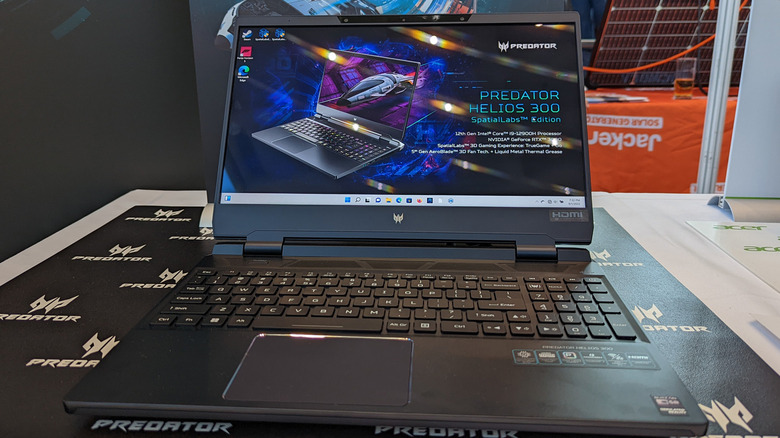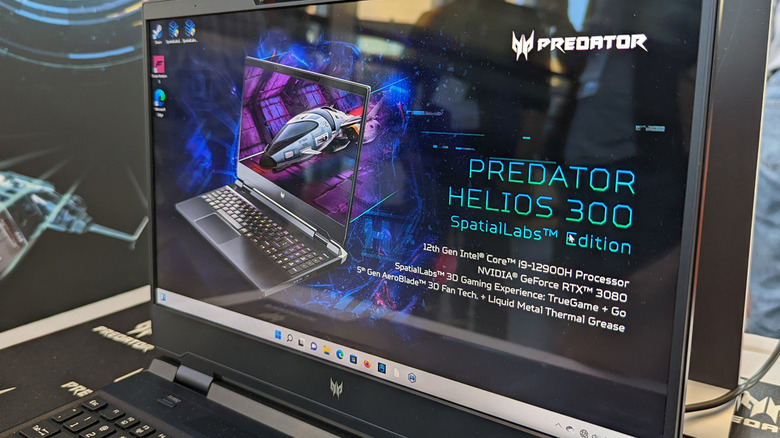The Coolest Features Of The Acer Predator Helios 300 SpatialLabs Edition
The Acer Predator Helios 300 SpatialLabs Edition gaming notebook brings a gaming fad back with promising results, but that's just one of its many cool features. Research in 2010 predicted the potential of computers with stereoscopic 3D — a feature that displays depth in objects without the need for 3D glasses — and how the technology will proliferate in up to 75 million PCs by 2014. However, that feature never really went mainstream in gaming hardware, aside from a few notable exceptions like the Nintendo 3DS. Taiwanese tech giant Acer, on the other hand, is working on getting stereoscopic 3D gaming back on track with its next-generation SpatialLabs Edition notebook.
This isn't Acer's first foray into the world of 3D laptops, as it first teased a prototype of its ConceptD notebook in 2021. That showcased how a stereoscopic 3D laptop aimed toward artists and designers could function in practical scenarios. The company explained how displaying image depth can aid in designing models accurately by allowing users to see how their design is projected in real space without the need for additional peripherals such as 3D glasses or other AR or VR headsets. Now, the SpatialLabs Edition of Acer's Helios 300 laptop hopes to achieve something similar, albeit with a bigger emphasis on gaming. Here's the kicker, though: Stereoscopic 3D is just one of the many Acer Predator Helios 300 SpatialLabs Edition features that are worth looking out for.
Acer Predator Helios 300 SpatialLabs Edition specs takes 3D to the Next-Gen
Acer's 3D gaming laptop is said to be the "first of its kind," showcasing stereoscopic 3D integration coupled with next-generation hardware and a cooling system (via Acer). So, what makes its internals so special? For starters, its 15.6-inch 4K display is comprised of liquid crystal lenticular lenses and eye-tracking stereoscopic 3D cameras. This makes it possible to switch between 2D and 3D views seamlessly, according to its press release. Acer's 3D gaming notebook utilizes machine-learning models that can automatically convert 2D models into 3D in real-time, while its RGB lighting uses Mini LED to illuminate each key individually at less power consumption. 3D isn't just limited to visuals either, as its DTS:X Ultra-enabled audio can make any headphone or speaker pump out 3D spatial surround sound.
The 3D laptop's cooling system is perhaps its coolest feature, literally, since its integrated dual AeroBlade fans, liquid metal thermal paste, and Acer's adaptive Coolboost technology ensures optimal performance regardless of its workload. Of course, the rest of the Predator Helios 300 SpatialLabs Edition specs also spare no expense in terms of gaming hardware, including Wi-Fi 6E capability via Intel's Killer network adapter, Core i9 CPU, and up to 32GB of DDR5 RAM. Topping off its gaming prowess is its dedicated Nvidia GeForce RTX 3080, a GPU that we rated favorably given its wealth of improvements. So, how does this all translate in terms of real-world usage?
What can you do with the Acer Predator Helios 300 SpatialLabs Edition features?
A 3D gaming laptop will likely have to rely on software that can support it, considering it's still a relatively niche market. Fortunately, Acer has a suite of 3D-focused software that makes the Predator Helios 300 SpatialLabs Edition notebook a force in both gaming and working. Acer's SpatialLabs Go can transform any 2D media into "simulated 3D" content with added depth at a push of a button. Aside from the usual pictures and videos, you can even add 3D depth in video calls, so your friends would be able to pop up at your place quite literally. As for 3D gaming, the SpatialLabs game support list already has over 50 titles, including games such as "God of War," "Forza Horizon 5," "Shadow of the Tomb Raider," and "The Witcher 3: Wild Hunt."
For productivity, creative designers and game developers can take full advantage of Acer's SpatialLabs Model Viewer. This software utilizes the laptop's eye-tracking lenses, allowing you to inspect various angles of 3D models by simply moving your head. What's even more intriguing is how you can interact with these virtual objects by pushing or pulling them in and out of the screen, Tony Stark style. The Acer Predator Helios 300 SpatialLabs price starts at $3,467 (€3,499), so those looking to get a taste of the future better start saving up.



